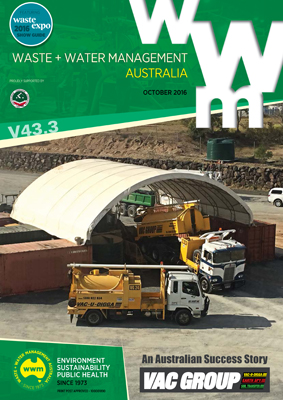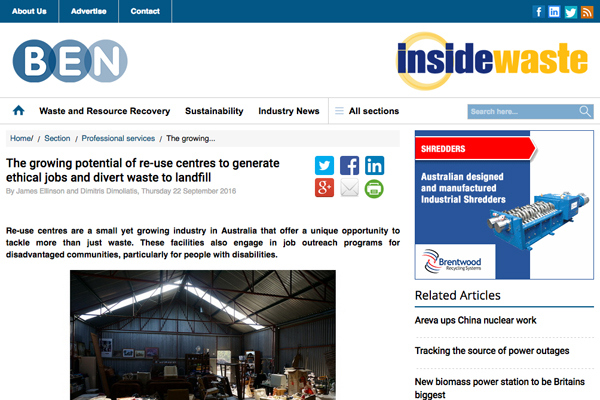The growing potential of re-use centres to generate ethical jobs and divert waste to landfill
By James Ellinson and Dimitris Dimoliatis, MRA Consulting Group
Re-use centres are a small, yet growing industry in Australia that offer a unique opportunity to tackle more than just waste. These facilities also engage in job outreach programs for disadvantaged communities, particularly for people with disabilities.
Re-use centres sell used, recycled and second hand products that have been salvaged rather than going to landfill. The majority are council run or community-based not-for-profit organisations. Re-use centres may also offer refurbishment, upcycling, processing and resale services while they frequently engage with their local communities to foster a positive attitude to the environment and drive education around waste minimisation behaviour. Some re-use centre operators such as The Endeavour Foundation and Willing & Able Foundation have also commitment to hiring people with disabilities.
“Also known as tip shops, recycle shops, junk yards…- Australia’s community recycling enterprises are reducing waste to landfill, creating jobs and strengthening communities all around Australia.”

The nature of the work, which involves cleaning and sorting through products, means that re-use centres are often labour intensive. On average, each of the 17 sites interviewed for this article employ 10 full/part time staff.
There is variability in the industry as some re-use centres salvage goods at the landfill, while others depend on the community to bring in quality second hand products. Some, such as the 23 year old Recovery Shop in Glenorchy, dubbed Australia’s first tip shop, also provide pick-up services to intercept construction and demolition material before entering landfill.
Similarly, the Bower in Sydney, a reuse and repair centre operating since 1998, offers a “Collection and Rehoming” service, a repair service for electronic appliances, furniture and bikes, an online shop and a variety of open-to-all workshops on art, repairs, upholstery and more. Reverse garbage next door, which has been running for over 40 years and has been self funded since 1991, also offers a variety of workshops.
Another successful example of a re-use centre that may be used as a blue print for new ones is in Brisbane. Brisbane City Council has contracted the operation of its re-use centres to the Endeavour Foundation, one of Australia’s largest non-government organisations (NGOs) supporting and providing opportunities for people with a disability. Last year alone, more than 520 tonnes of salvaged items were sold through Brisbane’s two tip shops.
Re-use centres add value to the waste management industry and are generally looked upon favourably by both the community and local government. The potential for re-use and recycling to generate employment is well known to be 3 jobs in recycling for every landfill job. For re-use centres, this can be as high as 10 jobs for every landfill job.
Recent data on re-use centre numbers and performance in Australia is hard to come by. A 2012 Community Recycling Network (CRN) study estimated that Community Recycling Enterprises (CRE) re-use centres alone diverted over 152,000t of material from landfill[1]. With a workforce of around 1,500, CRE re-use centres divert on average 100t per employee per year. As shown on Table 1 below, the 28 centres that took part in the study provided more employment opportunities of than the average landfill, while almost all (84%) provided training and employment opportunities for job seekers.
Table 1. Job creation and economic impact of CRE re-use centres (Source: CRN, 2012)
| Average per surveyed CRE re-use centre | Estimated total for CRE re-use centres | |
| Number of paid staff | 25 | 1,523 |
| Full time equivalent jobs | 14 | 1,010 |
| Number or trainees | 2 | 144 |
| Number of volunteers | 11 | 794 |
| Tonnes recovered annually | 2,347t | 152,543t |
| Income | $805,316 | $56,372,108 |
| Profit | $62,644 | $4,385,105 |
How then can we foster the establishment of more re-use centres and encourage them to offer more value-add services while also generating more jobs?
Educating the community on the benefits of their actions has definitely brought much needed attention to re-use centres around the nation and continued community education, delivered by Local and State Governments, will go a long way towards increasing the demand for quality re-use centres.
The supply side of things could also stand to benefit from government initiatives and funding that would help re-use centres to continue growing in Australia. Government support could be in the form of:
- Predictable and expanding market incentives:
- landfill levies;
- diversion targets; and
- government subsidies (particularly for the start-up costs).
- Incentives for existing centres to diversify and create quality jobs:
- subsidised/ free training for re-use centre employees; and
- grants for upgrades to re-use centres wishing to provide services that increase the value of recovered items such as repairs to white goods and upcycling of furniture.
- Foster and support the creation of a national association of tip shop operators.
- Financial and in kind support from Councils, such as the integration of re-use shops into their waste management systems and resident educational/marketing material.
To deal with electronic products that have been rendered obsolete through technical advances, re-use centres should be encouraged to invest in the infrastructure and employee training necessary to recover the valuable components of these products. The sum of the disassembled parts of a CRT TV is much more valuable than the TV itself and re-use shops should be encouraged to extract that value.
According to the Department of the Environment and Energy there are 806 resource recovery facilities around Australia. Most of these do not have a re-use centre on site. With the right incentives, re-use centres can be established within or in association with these facilities. This is a great opportunity to provide many more good quality, ethical jobs, particularly for people from disadvantaged backgrounds and people with disabilities.
Re-use centres offer new and exciting opportunities to achieve positive outcomes for the community, disadvantaged groups, and the environment. While the scale of the investment required is modest, the opportunity to empower communities, raise community awareness of waste issues, assist disadvantaged people and create employment opportunities while helping with landfill diversion is significant.
As always, we welcome your feedback on this, or any other topic on ‘The Tipping Point’.
[1] Given that not all re-use centres are CRE and that since 2012 more re-use centres have opened in Australia, the total volume diverted is likely to be higher.
This article has been published by the following media outlets:
 Waste + Water Management Australia, October 2016 (click to view)
Waste + Water Management Australia, October 2016 (click to view)




